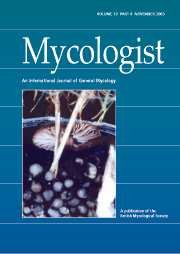Crossref Citations
This article has been cited by the following publications. This list is generated based on data provided by
Crossref.
2000.
21st Century Guidebook to Fungi.
p.
3.
Burford, E. P.
Fomina, M.
and
Gadd, G. M.
2003.
Fungal involvement in bioweathering and biotransformation of rocks and minerals.
Mineralogical Magazine,
Vol. 67,
Issue. 6,
p.
1127.
Fomina, Marina
Gadd, Geoffrey
and
Burford, Euan
2005.
The Fungal Community.
Vol. 20050554,
Issue. ,
p.
733.
Gleeson, Deirdre B.
Clipson, Nicholas
Melville, Karrie
Gadd, Geoffrey M.
and
McDermott, Frank P.
2005.
Characterization of Fungal Community Structure on a Weathered Pegmatitic Granite.
Microbial Ecology,
Vol. 50,
Issue. 3,
p.
360.
Gadd, Geoffrey M.
2005.
Microorganisms in Soils: Roles in Genesis and Functions.
Vol. 3,
Issue. ,
p.
325.
Burford, Euan P.
Hillier, Stephen
and
Gadd, Geoffrey M.
2006.
Biomineralization of Fungal Hyphae with Calcite (CaCO3) and Calcium Oxalate Mono- and Dihydrate in Carboniferous Limestone Microcosms.
Geomicrobiology Journal,
Vol. 23,
Issue. 8,
p.
599.
Fomina, Marina
Burford, Euan P.
and
Gadd, Geoffrey M.
2006.
Fungi in Biogeochemical Cycles.
p.
236.
Botha, Alfred
2006.
Biodiversity and Ecophysiology of Yeasts.
p.
221.
Reitner, Joachim
Schumann, Gabriela
and
Pedersen, Karsten
2006.
Fungi in Biogeochemical Cycles.
p.
377.
Verrecchia, Eric P.
Braissant, Olivier
and
Cailleau, Guillaume
2006.
Fungi in Biogeochemical Cycles.
p.
289.
Morris, Cindy E.
Kinkel, Linda L.
Xiao, Kun
Prior, Philippe
and
Sands, David C.
2007.
Surprising niche for the plant pathogen Pseudomonas syringae.
Infection, Genetics and Evolution,
Vol. 7,
Issue. 1,
p.
84.
Dupont, Joëlle
Jacquet, Claire
Dennetière, Bruno
Lacoste, Sandrine
Bousta, Faisl
Orial, Geneviève
Cruaud, Corinne
Couloux, Arnaud
and
Roquebert, Marie-France
2007.
Invasion of the French Paleolithic painted cave of Lascaux by members of theFusarium solanispecies complex.
Mycologia,
Vol. 99,
Issue. 4,
p.
526.
Fomina, M.
Podgorsky, V. S.
Olishevska, S. V.
Kadoshnikov, V. M.
Pisanska, I. R.
Hillier, S.
and
Gadd, G. M.
2007.
Fungal Deterioration of Barrier Concrete used in Nuclear Waste Disposal.
Geomicrobiology Journal,
Vol. 24,
Issue. 7-8,
p.
643.
Gadd, Geoffrey M.
2007.
Geomycology: biogeochemical transformations of rocks, minerals, metals and radionuclides by fungi, bioweathering and bioremediation.
Mycological Research,
Vol. 111,
Issue. 1,
p.
3.
Kolo, Kamal
Keppens, Eddy
Préat, Alain
and
Claeys, Philippe
2007.
Experimental observations on fungal diagenesis of carbonate substrates.
Journal of Geophysical Research: Biogeosciences,
Vol. 112,
Issue. G1,
GADD, G. M.
2008.
Bacterial and fungal geomicrobiology: a problem with communities?.
Geobiology,
Vol. 6,
Issue. 3,
p.
278.
Gadd, G.M.
2008.
Encyclopedia of Ecology.
p.
1709.
Miller, Ana Zélia
Laiz, Leonila
Gonzalez, Juan Miguel
Dionísio, Amélia
Macedo, Maria Filomena
and
Saiz-Jimenez, Cesareo
2008.
Reproducing stone monument photosynthetic-based colonization under laboratory conditions.
Science of The Total Environment,
Vol. 405,
Issue. 1-3,
p.
278.
Campos, Juan A.
Tejera, Noel A.
and
Sánchez, Carlos J.
2009.
Substrate role in the accumulation of heavy metals in sporocarps of wild fungi.
BioMetals,
Vol. 22,
Issue. 5,
p.
835.
Cockell, Charles S.
Olsson, Karen
Knowles, Felicity
Kelly, Laura
Herrera, Aude
Thorsteinsson, Thorsteinn
and
Marteinsson, Viggo
2009.
Bacteria in Weathered Basaltic Glass, Iceland.
Geomicrobiology Journal,
Vol. 26,
Issue. 7,
p.
491.




